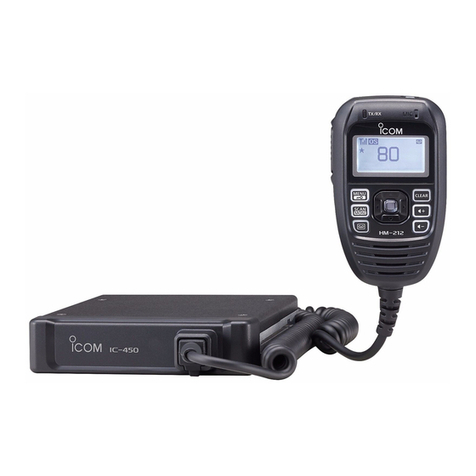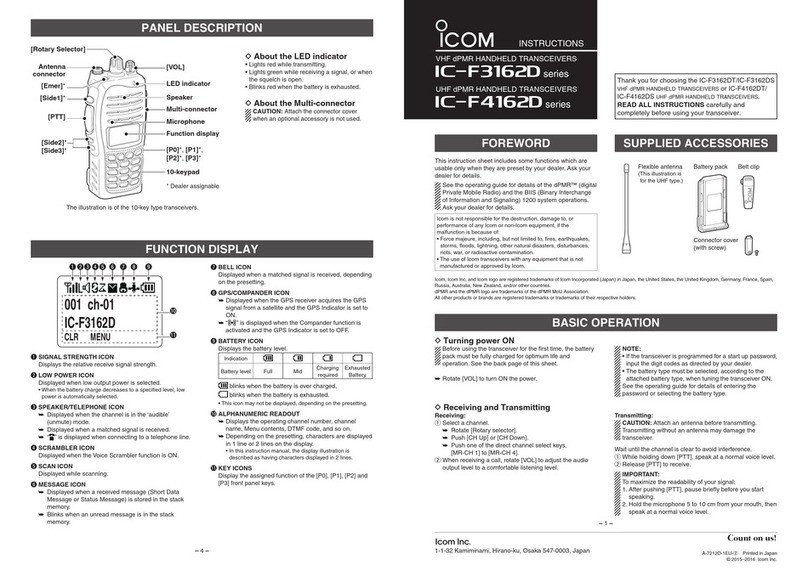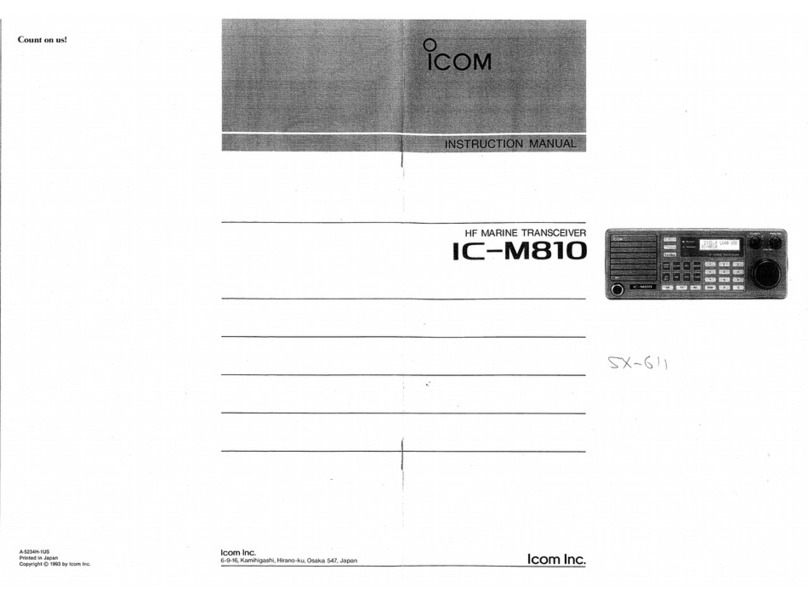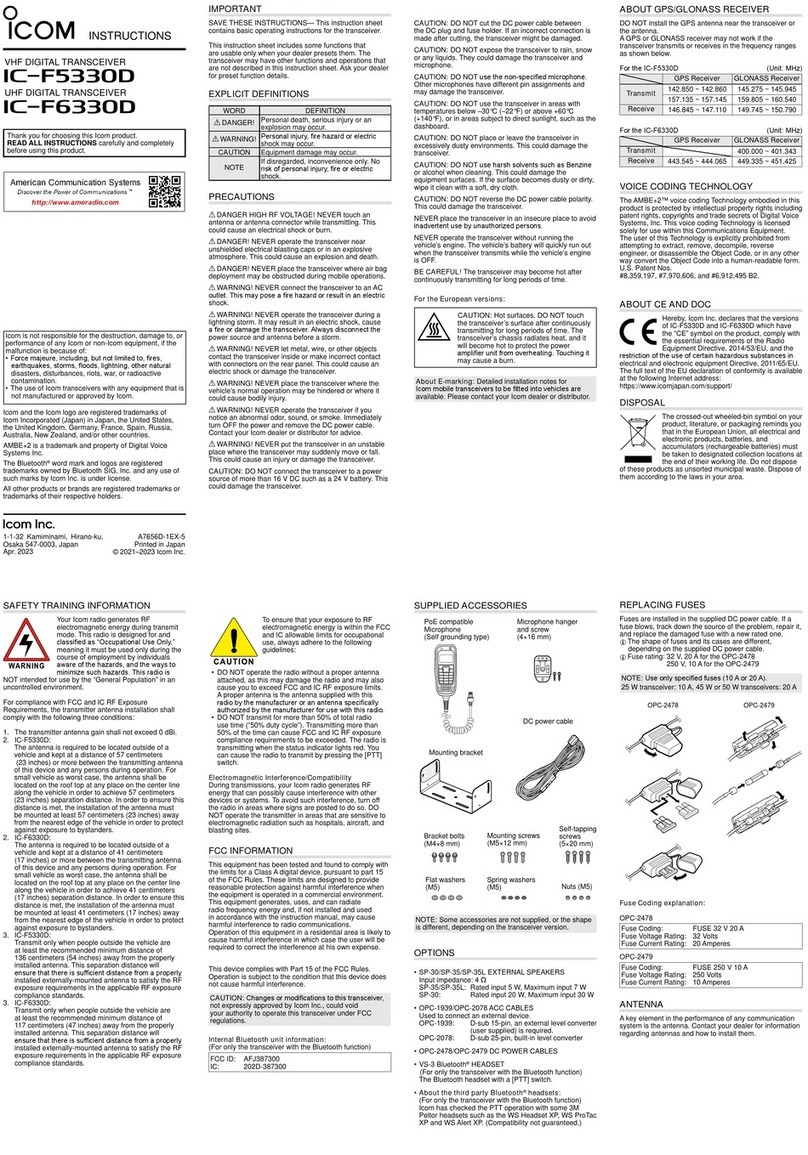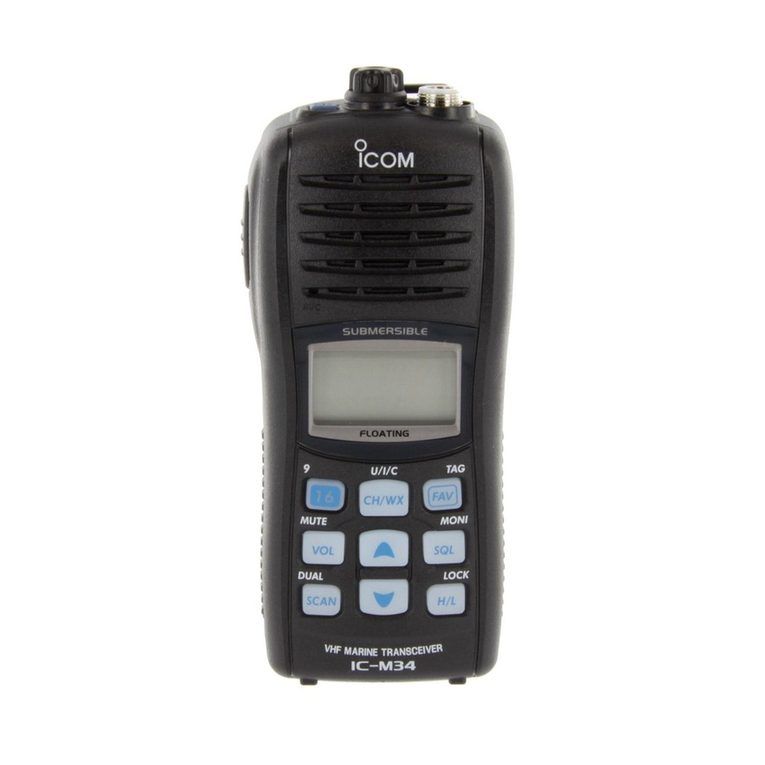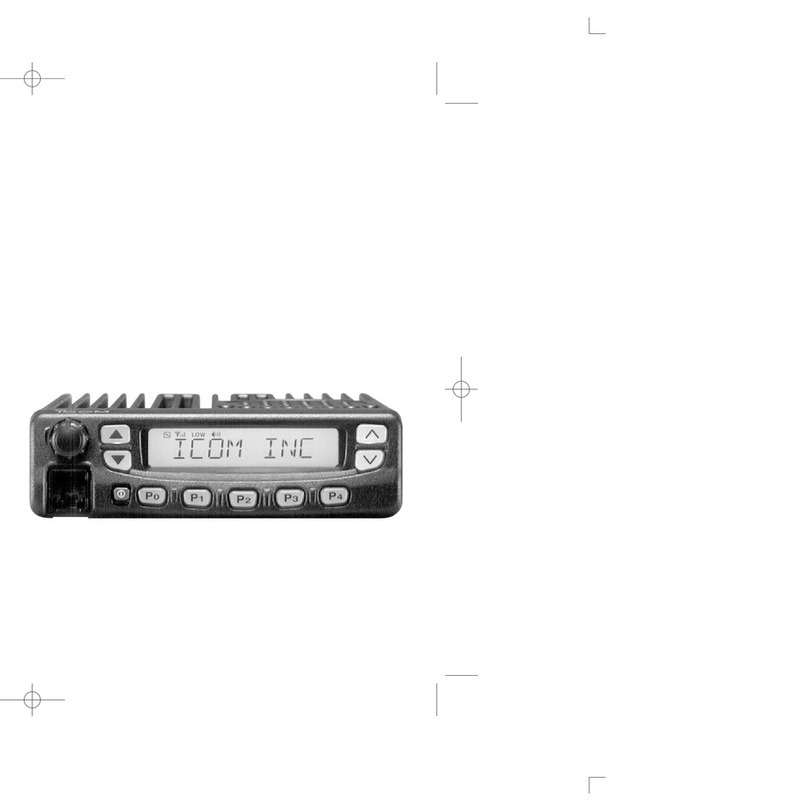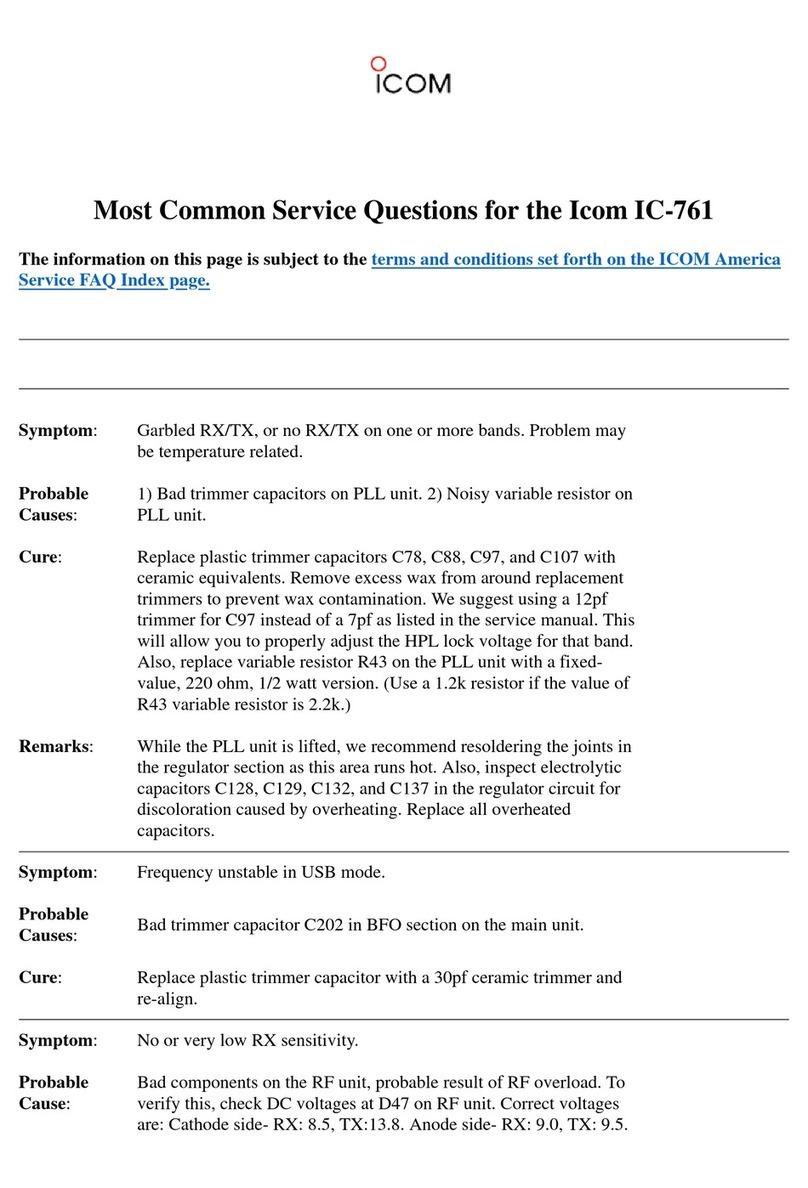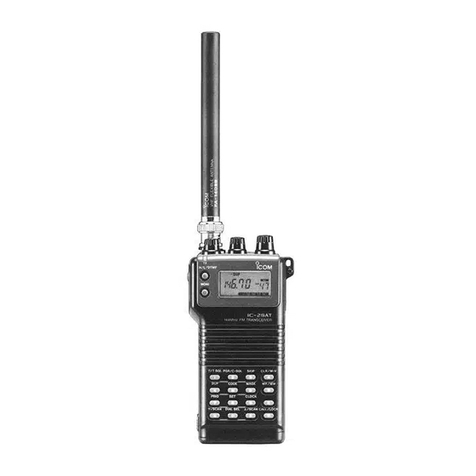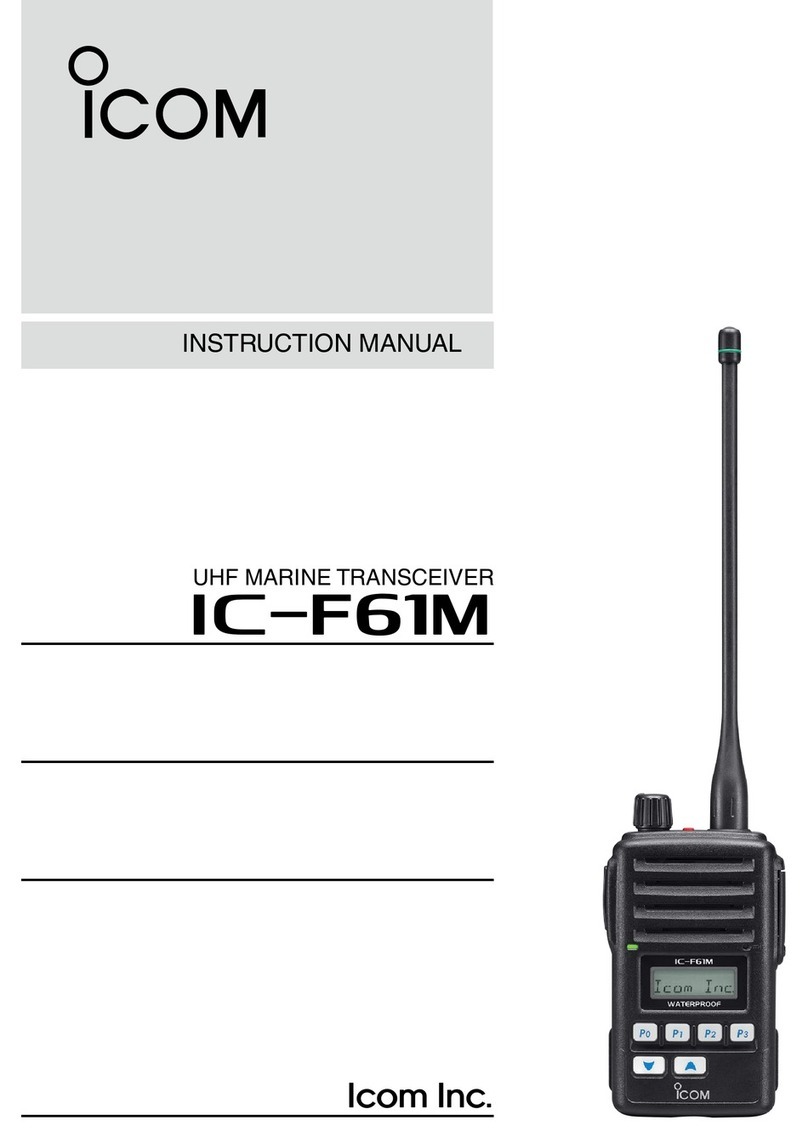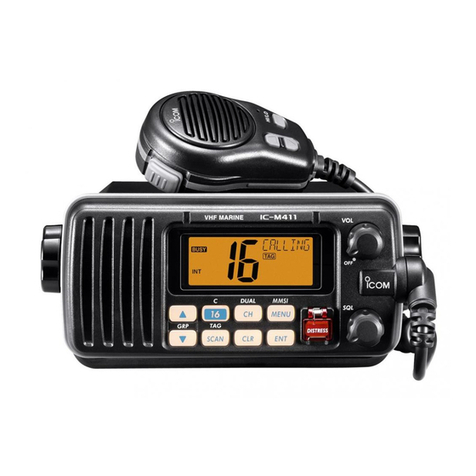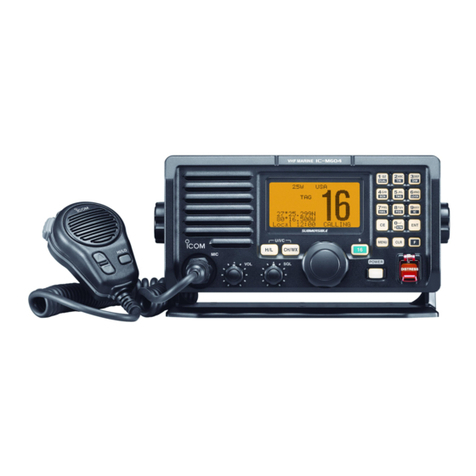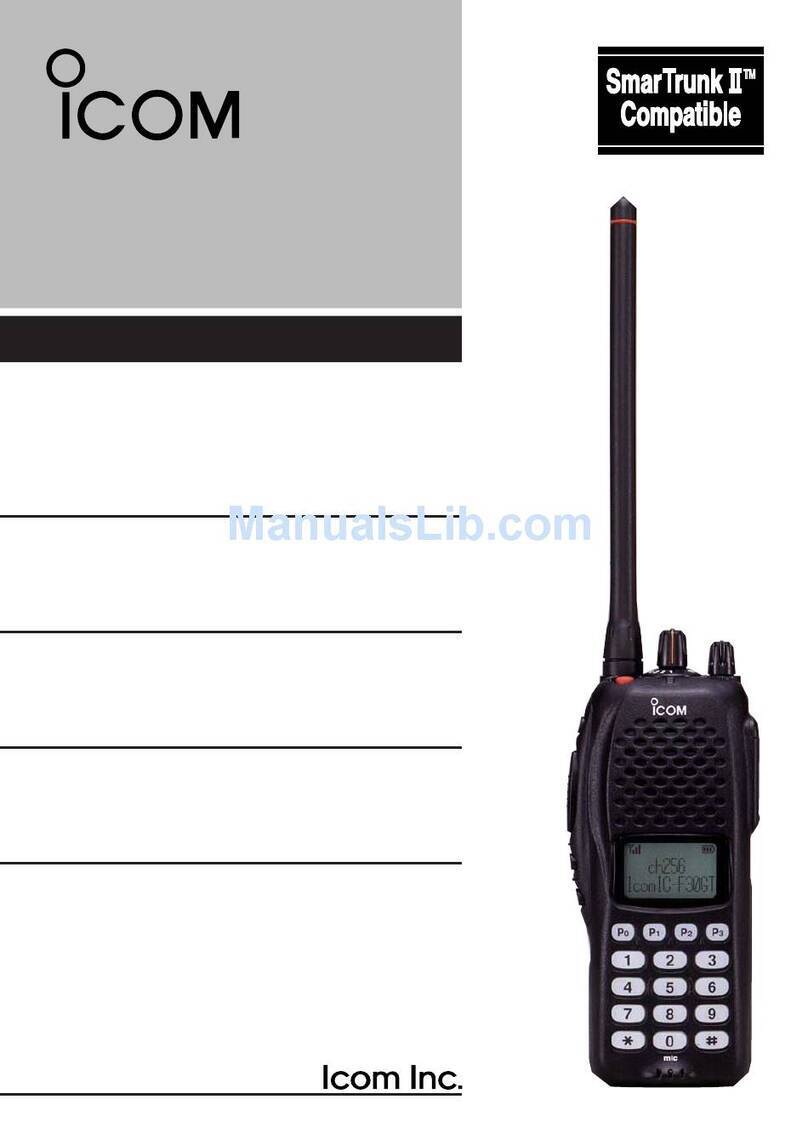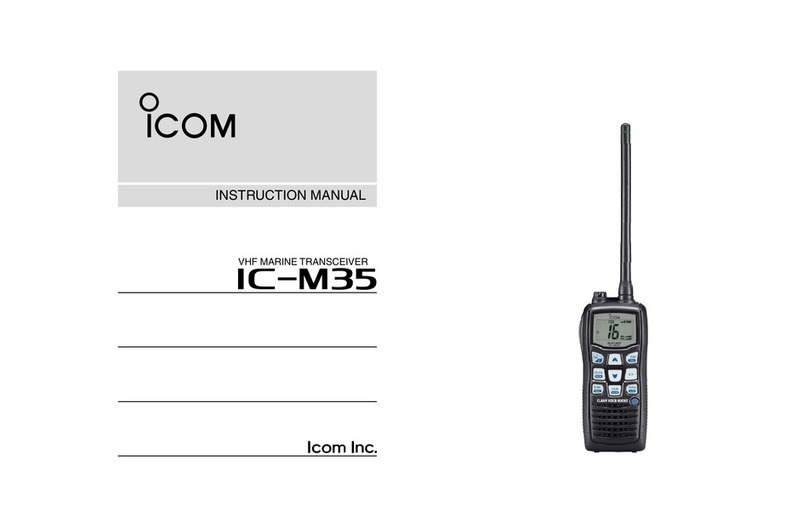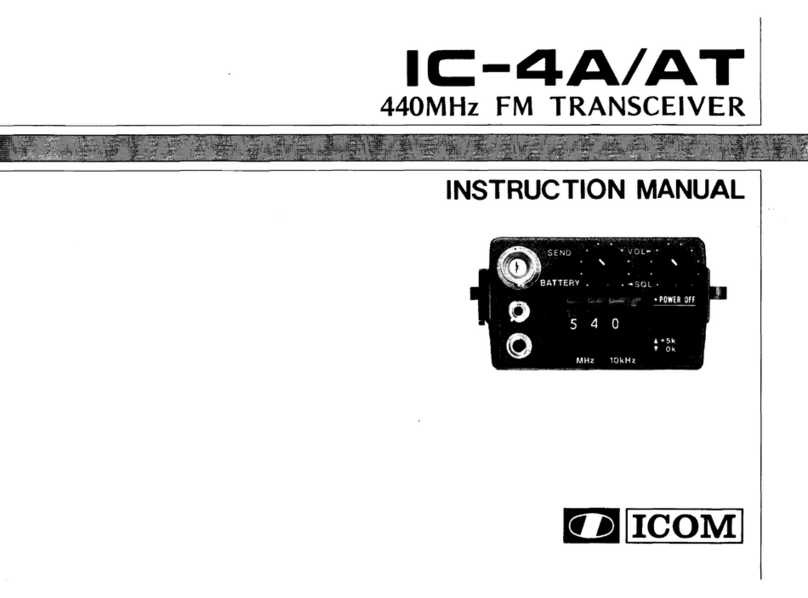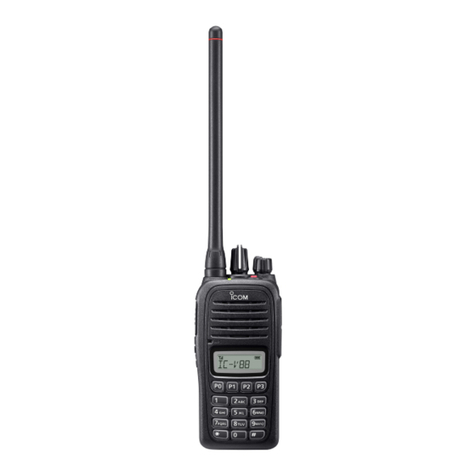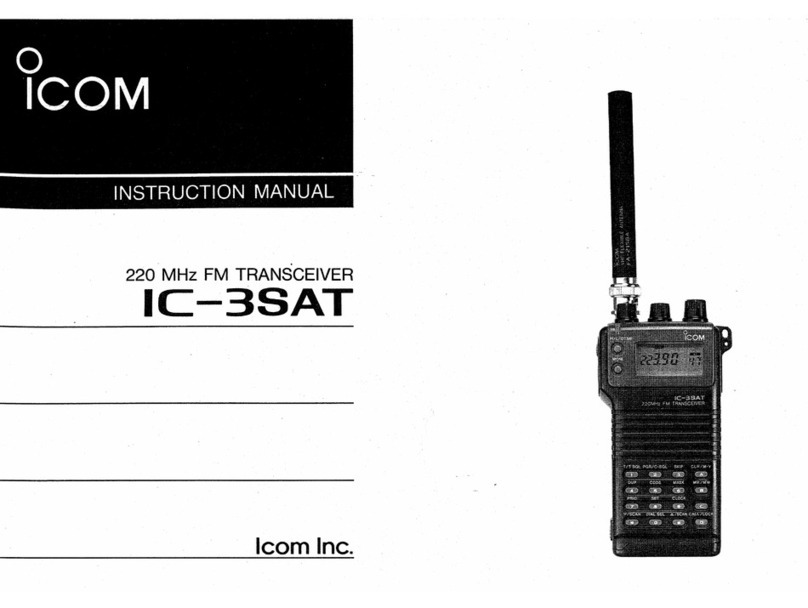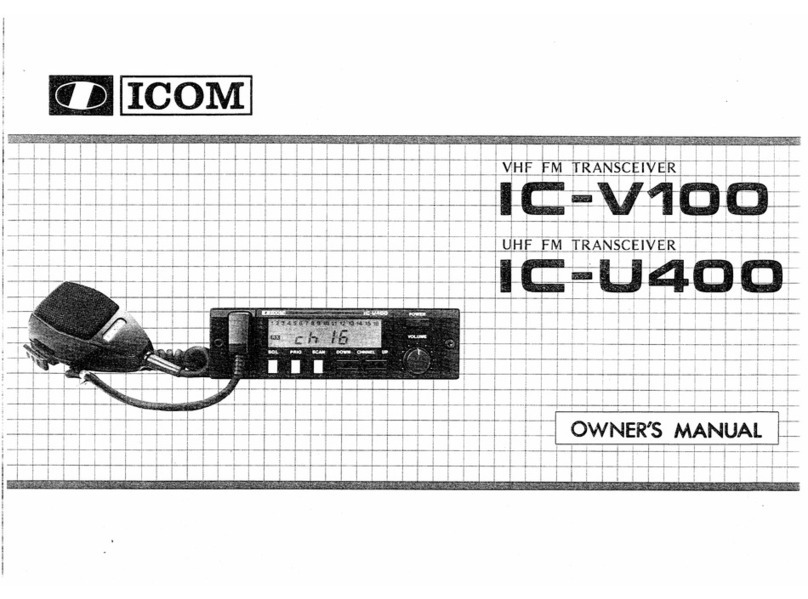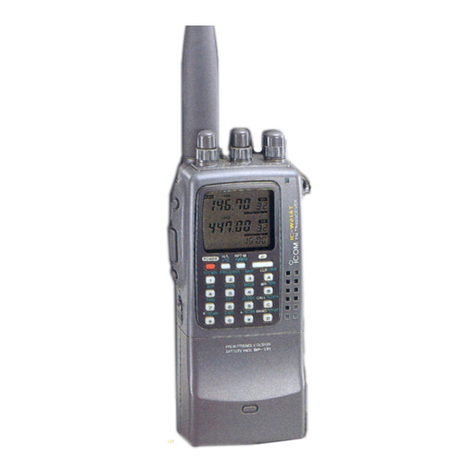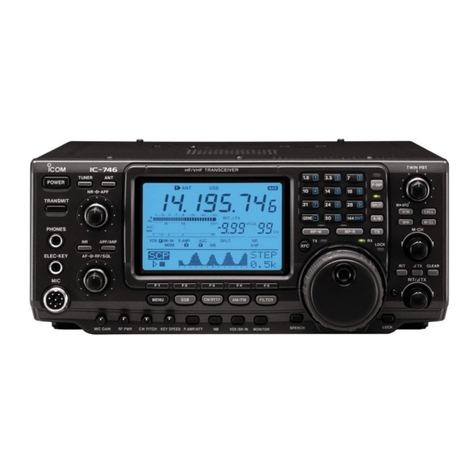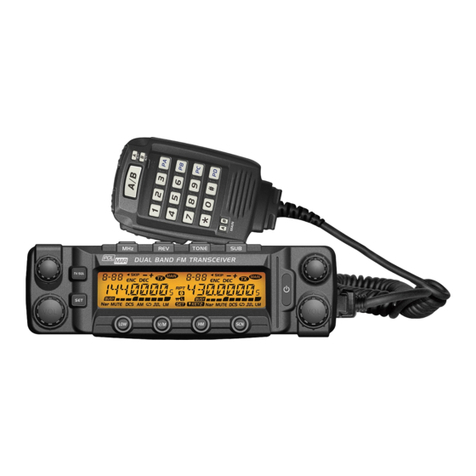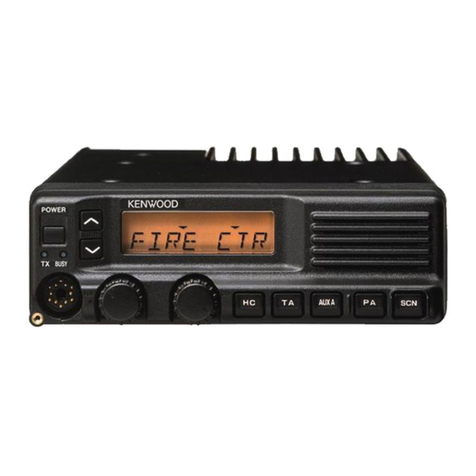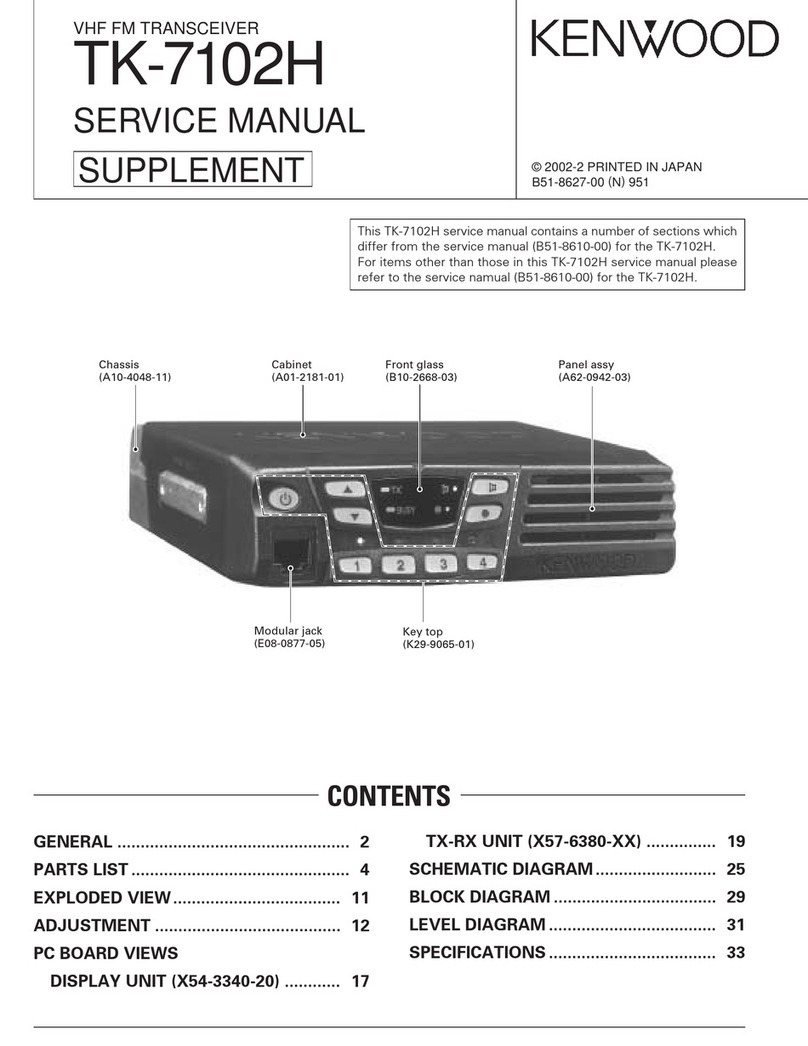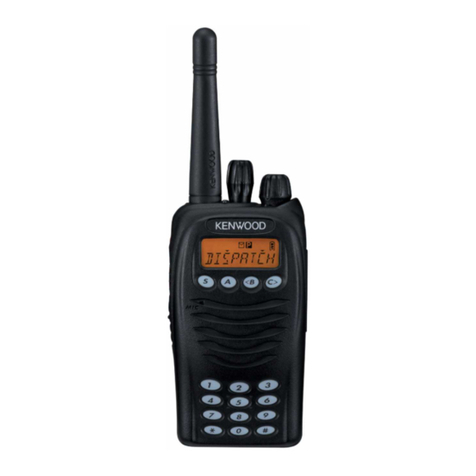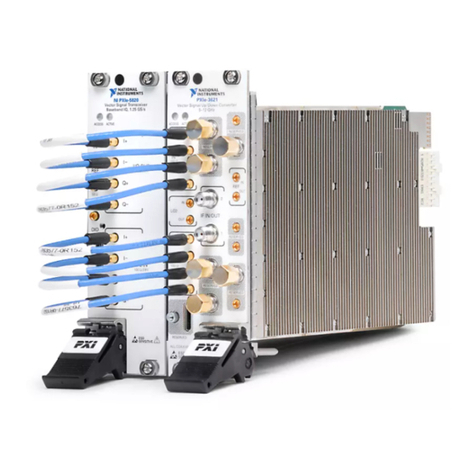Icom IM323 User manual

INSTRUCTION MANUAL
iM323
iM323G
iM324
iM324G
VHF MARINE TRANSCEIVER
This device complies with Part 15 of the FCC
Rules. Operation is subject to the condition that
this device does not cause harmful interference.

i
FOREWORD
Thank you for purchasing this Icom product. The IC-M323/
IC-M323G/IC-M324/IC-M324G V H F M A R I N E T R A N S C E I V E R is
designed and built with Icom’s state of the art technology and
craftsmanship. With proper care, this product should provide
you with years of trouble-free operation.
We appreciate you making the IC-M323, IC-M323G, IC-M324,
or IC-M324G your radio of choice, and hope you agree with
Icom’s philosophy of “technology first.” Many hours of research
and development went into the design of your radio.
FEATURESD
❍Simple operation with large keys
❍Easy to hear speaker
❍Built-in DSC meets ITU Class D requirement
❍Rugged waterproof construction
❍Easy to make an individual DSC calls using the
optional MA-500TR Class B AIS Transponder
IMPORTANT
READ ALL INSTRUCTIONS carefully and completely
before using the transceiver.
SAVE THIS INSTRUCTION MANUAL — This in-
struction manual contains important operating instructions
for the transceiver.
EXPLICIT DEFINITIONS
WORD DEFINITION
RWARNING! Personal injury, fire hazard or electric
shock may occur.
CAUTION Equipment damage may occur.
NOTE
If disregarded, inconvenience only. No risk
of personal injury, fire or electric shock.
CLEAN THETRANSCEIVER AND MICROPHONETHOR-
OUGHLY WITH FRESH WATER after exposure to water
including salt, otherwise, the keys and switch may become
inoperable due to salt crystallization.

IN CASE OF EMERGENCY
If your vessel requires assistance, contact other vessels and
the Coast Guard by sending a Distress call on Channel 16.
Or, transmit your Distress call using digital selective calling
on Channel 70.
USING CHANNEL 16
DISTRESS CALL PROCEDURE
1. “MAYDAY MAYDAY MAYDAY.”
2. “THIS IS ...............” (name of vessel).
3. Say your call sign or other description of the vessel (AND
9 digit DSC ID if you have one).
4. “LOCATED AT ...............” (your position).
5. State the nature of the distress and assistance required.
6. Give any other information which might facilitate the res-
cue.
USING DIGITAL SELECTIVE CALLING (Ch 70)
DISTRESS CALL PROCEDURE
1. While lifting up the key cover, hold down [DISTRESS]
for 3 seconds until you hear 3 short beeps and then one
long beep.
2. Wait for an acknowledgment on Channel 70 from a coast
station.
-
matically selected.
3. Hold down [PTT], then transmit the appropriate informa-
tion as listed above.
ii
INSTALLATION NOTE
Installation:
The installation of this equipment should be made in such a
manner as to respect the EC recommended electromagnetic
field exposure limits. (1999/519/EC)
The maximum RF power available from this device is 25
watts. The antenna should be installed as high as possible
for maximum efficiency and the installation height should be
at least 1.4 meters above any accessible position. In the case
where an antenna cannot be installed at a reasonable height,
then the transmitter should neither be continuously operated
for long periods if any person is within a distance of 1.4 me-
ters of the antenna, nor operated at all if any person is touch-
ing the antenna.
It is recommended that antenna of a maximum gain of 3 dB
are used. If higher gain antenna are required then please
contact your Icom distributor for revised installation recom-
mendations.
Operation:
The exposure to RF electromagnetic field is only applicable
when this device is transmitting. This exposure is naturally
reduced due to the nature of alternating periods of receiving
and transmitting. Keep your transmissions to the minimum
necessary.

iii
11 CHAPTER CONTINUED
RADIO OPERATOR WARNING
WARNING
Icom requires the radio operator to meet the
FCC Requirements for Radio Frequency Expo-
sure. An omnidirectional antenna with gain not
greater than 9 dBi must be mounted a mini-
mum of 5 meters (measured from the lowest
point of the antenna) vertically above the main
deck and all possible personnel. This is the minimum safe
separation distance estimated to meet all RF exposure com-
pliance requirements. This 5 meter distance is based on the
FCC Safe Maximum Permissible Exposure (MPE) distance
of 3 meters added to the height of an adult (2 meters) and is
appropriate for all vessels.
For watercraft without suitable structures, the antenna must
be mounted so as to maintain a minimum of 1 meter verti-
cally between the antenna, (measured from the lowest point
of the antenna), to the heads of all persons AND all persons
must stay outside of the 3 meter MPE radius.
Do not transmit with radio and antenna when persons are
within the MPE radius of the antenna, unless such persons
(such as driver or radio operator) are shielded from antenna
field by a grounded metallic barrier. The MPE Radius is the
minimum distance from the antenna axis that person should
maintain in order to avoid RF exposure higher than the al-
lowable MPE level set by FCC.
FAILURE TO OBSERVE THESE LIMITS MAY ALLOW
THOSE WITHIN THE MPE RADIUS TO EXPERIENCE RF
RADIATION ABSORPTION WHICH EXCEEDS THE FCC
MAXIMUM PERMISSIBLE EXPOSURE (MPE) LIMIT.
IT IS THE RESPONSIBILITY OF THE RADIO OPERATOR
TO ENSURE THAT THE MAXIMUM PERMISSIBLE EXPO-
SURE LIMITS ARE OBSERVED AT ALL TIMES DURING
RADIO TRANSMISSION. THE RADIO OPERATOR IS TO
ENSURE THAT NO BYSTANDERS COME WITHIN THE
RADIUS OF THE MAXIMUM PERMISSIBLE EXPOSURE
LIMITS.
Determining MPE Radius
THE MAXIMUM PERMISSIBLE EXPOSURE (MPE) RA-
DIUS HAS BEEN ESTIMATED TO BE A RADIUS OF
ABOUT 3M PER OET BULLETIN 65 OF THE FCC.
THIS ESTIMATE IS MADE ASSUMING THE MAXIMUM
POWER OF THE RADIO AND ANTENNAS WITH A MAXI-
MUM GAIN OF 9dBi ARE USED FOR A SHIP MOUNTED
SYSTEM.

iv
11
CHAPTER CONTINUED
1
2
3
4
5
6
7
8
9
10
11
12
13
14
15
16
AVERTISSEMENT POUR LES OPÉRATEURS RADIO
Icom exige que l'opérateur radio se conforme aux
exigences de la FCC en matière d'exposition aux
radiofréquences. Une antenne omnidirectionnelle
dont le gain ne dépasse pas 9dBi doit être fixée
à une distance minimale de 5 mètres (mesurée
depuis le point le plus bas de l'antenne) verticale-
ment au-dessus du pont principal et de tout le personnel qui peut
s'y trouver. Il s'agit de la distance de sécurité minimale prévue pour
satisfaire aux exigences de conformité en matière d'exposition aux
RF. Cette distance de 5 mètres est établie en fonction de l'exposition
maximale admissible sécuritaire de 3 mètres établie par la FCC, à
laquelle on ajoute la hauteur d'un adulte (2 mètres); cette distance
convient pour tous les navires.
Dans le cas des embarcations sans structure convenable, l'antenne
doit être fixée de façon à maintenir une distance minimale de 1 mètre
verticalement entre cette antenne (mesurée depuis son point le plus
bas) et la tête de toute personne présente; toutes les personnes
présentes doivent se tenir à l'extérieur d'un rayon d'exposition maxi-
male admissible de 3 mètres.
Ne pas émettre à l'aide de la radio et de l'antenne lorsque des
personnes se trouvent à l'intérieur du rayon d'exposition maximale
admissible de cette antenne, à moins que ces personnes (comme
le conducteur ou l'opérateur radio) ne soient protégées du champ
de l'antenne par un écran métallique relié à la masse. Le rayon
d'exposition maximale admissible équivaut à la distance minimale
que cette personne doit maintenir entre elle et l'axe de l'antenne pour
éviter une exposition aux RF supérieure au niveau d'exposition maxi-
male admissible fixé par la FCC.
LE NON-RESPECT DE CES LIMITES PEUT CAUSER, POUR LES
PERSONNES SITUÉES DANS LE RAYON D'EXPOSITION MAXI-
MALE ADMISSIBLE, UNE ABSORPTION DE RAYONNEMENT DE
RF SUPÉRIEURE À L'EXPOSITION MAXIMALE ADMISSIBLE
FIXÉE PAR LA FCC.
L'OPÉRATEUR RADIO EST RESPONSABLE D'ASSURER QUE
LES LIMITES D'EXPOSITION MAXIMALE ADMISSIBLE SOIENT
RESPECTÉES EN TOUT TEMPS PENDANT LA TRANSMISSION
RADIO. L'OPÉRATEUR RADIO DOIT S'ASSURER QU'AUCUNE
PERSONNE PRÉSENTE NE SE SITUE À L'INTÉRIEUR DU RAY-
ON D'EXPOSITION MAXIMALE ADMISSIBLE.
Établir le rayon d'exposition maximale admissible
ON ESTIME QUE LE RAYON D'EXPOSITION MAXIMALE ADMIS-
SIBLE EST D'ENVIRON 3 M, TEL QUE STIPULÉ DANS LE BUL-
LETIN OET 65 DE LA FCC. CETTE DISTANCE ESTIMÉE TIENT
COMPTE D'UN SYSTÈME INSTALLÉ SUR UN NAVIRE UTILISANT
LA PUISSANCE MAXIMALE DE LA RADIO ET DES ANTENNES
DONT LE GAIN MAXIMAL EST DE 9dBi.
AVERTISSEMENT

v
FCC INFORMATION
•FORCLASSAUNINTENTIONALRADIATORS:This equipment has been tested and found to comply with the
limits for a Class A digital device, pursuant to part 15 of the
FCC Rules. These limits are designed to provide reasonable
protection against harmful interference when the equipment
is operated in a commercial environment. This equipment
generates, uses, and can radiate radio frequency energy
and, if not installed and used in accordance with the instruc-
tion manual, may cause harmful interference to radio com-
munications.
Operation of this equipment in a residential area is likely to
cause harmful interference in which case the user will be re-
quired to correct the interference at his own expense.
NOTE
INFORMATION FCC
•POURLESRAYONNEMENTSNONINTENTIONNELSDECLASSEA:Cet équipement a été testé et reconnu conforme aux limites fixées
pour un appareil numérique de classe A, conformément au point
15 de la réglementation FCC. Ces limites sont définies de façon à
fournir une protection raisonnable contre le brouillage préjudiciable
lorsque cet appareil est utilisé dans un environnement commercial.
Cet équipement génère, utilise et peut émettre un rayonnement de
fréquence radio. S'il n'a pas été installé conformément aux instruc-
tions, il peut par ailleurs créer des interférences perturbant les com-
munications radio.
L'utilisation de cet appareil dans une zone résidentielle peut provo-
quer un brouillage préjudiciable, auquel cas l'utilisateur sera tenu de
corriger la situation à ses frais.
NOTE
A WARNING STICKER is supplied with the
U.S.A. version transceiver.
To comply with FCC regulations, this sticker
must be affixed in such a location as to be
readily seen from the operating controls of the
radio as in the diagram below. Make sure the
chosen location is clean and dry before apply-
ing the sticker.
UN AUTOCOLLANT D'AVERTISSEMENT est
fourni avec la version américaine de l'émetteur-
récepteur.
Selon la réglementation du FCC, cet autocollant
doit être placé à un endroit où il sera vu facilement
par l'utilisateur aux commandes de la radio, comme
l'illustre le diagramme ci-dessous. Assurez-vous que
la surface est propre et sèche avant d'y appliquer
l'autocollant.
WARNING.
EXAMPLE EXEMPLE

vi
1
2
3
4
5
6
7
8
9
10
11
12
13
14
15
16
PRECAUTIONS
Icom, Icom Inc. and the Icom logo are registered trademarks of Icom Incor-
porated (Japan) in Japan, the United States, the United Kingdom, Germany,
France, Spain, Russia and/or other countries.
RWARNING! NEVER
connect the transceiver to an AC
outlet. This may pose a fire hazard or result in an electric shock.
RWARNING! NEVER connect the transceiver to a pow-
er source of more than 16 V DC or use reverse polarity. This
will ruin the transceiver.
RWARNING! NEVER cut the DC power cable between
the DC plug at the back of the transceiver and fuse holder. If
an incorrect connection is made after cutting, the transceiver
may be damaged.
CAUTION:NEVER
place the transceiver where normal
operation of the vessel may be hindered or where it could
cause bodily injury.
KEEP the transceiver and microphone at least 1 m away
from the vessel’s magnetic navigation compass.
DO NOT use or place the transceiver in areas with tem-
peratures below –20°C (–4°F) or above +60°C (+140°F) or, in
areas subject to direct sunlight, such as the dashboard.
DO NOT use harsh solvents such as benzine or alcohol to
clean the transceiver, as they will damage the transceiver’s
surfaces. If the transceiver becomes dusty or dirty, wipe it
clean with a soft, dry cloth.
DO NOT disassemble or modify the transceiver for any rea-
son.
BE CAREFUL! The transceiver rear panel will become
hot when operating continuously for long periods of time.
Place the transceiver in a secure place to avoid inadvertent
use by children.
BE CAREFUL!The transceiver meets IPX7*requirements
for waterproof protection. However, once the transceiver has
been dropped, waterproof protection cannot be guaranteed
because of possible damage to the transceiver’s case or the
waterproof seal.
* Except for the DC power connector, NMEA In/Out leads and AF
Out leads.
For U.S.A. only
CAUTION:Changes or modifications to this device, not ex-
pressly approved by Icom Inc., could void your authority to
operate this device under FCC regulations.

vii
PRÉCAUTIONS
RAVERTISSEMENT! NE JAMAIS
connecter l’emetteur-
recepteur a une alimentation CA au risque de provoquer un in-
cendie ou un choc electrique.
R
AVERTISSEMENT!
NE JAMAIS
connecter
l’émetteur-récepteur à une alimentation d’une tension su-
périeure à 16 V CC, ni inverser la polarité, au risque de détru-
ire l’émetteur-récepteur.
R
AVERTISSEMENT!
NE JAMAIS
sectionner le câble
d'alimentation CC entre la prise CC de la face arrière de
l'émetteur-récepteur et le porte-fusible. L’émetteur-récepteur
peut être endommagé par la suite en cas de connexion inap-
propriée.
MISEENGARDE:
NE JAMAIS
installer l’émetteur-
récepteur à un emplacement où il pourrait gêner le fonction-
nement normal du navire ou provoquer des blessures cor-
porelles.
MAINTENIR l'émetteur-récepteur et le microphone à au
moins 1 mètre du compas de route magnétique du navire.
NE PAS utiliser ou placer l’émetteur-récepteur dans des
zones où la temperature est inférieure à –20° (–4°F) ou
supérieure à +60° (+140°F) ou dans des zones soumises
au rayonnement solaire direct, telles le tableau de bord.
NE PAS nettoyer l'appareil avec des solvants agressifs tels
que benzène ou alcool, susceptibles d'endommager les sur-
faces exposées du boîtier. En cas de dépôt de poussière ou
de salissures sur l'émetteur-récepteur, il faut l'essuyer avec
chiffon doux et sec.
NE PAS démonter ou modifier l'émetteur-récepteur pour
quelque raison que ce soit.
ATTENTION! La face arrière de l’émetteur-récepteur
chauffe en cas d’utilisation continue sur une longue durée.
Placer l’émetteur-récepteur hors de portée des enfants pour
éviter toute utilisation inopinée.
ATTENTION! Le récepteur est conforme à la norme
d'étanchéité IPX7*. Cependant, cette etancheite n’est plus
garantie apres une chute de l’appareil en raison des fissures
du boitier ou des dommages au joint d’etancheite et autres
dommages eventuels consecutifs a un tel incident.
* À l'exception du connecteur d'alimentation CC, des fils d'entrée ou
de sortie NMEA et des fils de sortie de fréquences audio.
U.S.A. uniquement
ATTENTION:Tout changement ou modification, non expres-
sément approuvé par Icom Inc., peut annuler l'autorisation
de l'utilisateur à utiliser cet appareil conformément à la régle-
mentation FCC.

viii
COUNTRY CODE LIST
•ISO3166-1Country Codes Country Codes
1
2
3
4
5
6
7
8
9
10
11
12
13
14
15
16
17
Austria
Belgium
Bulgaria
Croatia
Czech Republic
Cyprus
Denmark
Estonia
Finland
France
Germany
Greece
Hungary
Iceland
Ireland
Italy
Latvia
AT
BE
BG
HR
CZ
CY
DK
EE
FI
FR
DE
GR
HU
IS
IE
IT
LV
18
19
20
21
22
23
24
25
26
27
28
29
30
31
32
33
Liechtenstein
Lithuania
Luxembourg
Malta
Netherlands
Norway
Poland
Portugal
Romania
Slovakia
Slovenia
Spain
Sweden
Switzerland
Turkey
United Kingdom
LI
LT
LU
MT
NL
NO
PL
PT
RO
SK
SI
ES
SE
CH
TR
GB
TABLE OF CONTENTS
FOREWORD .........................................................................i
IMPORTANT..........................................................................i
EXPLICIT DEFINITIONS....................................................... i
IN CASE OF EMERGENCY................................................. ii
INSTALLATION NOTE.......................................................... ii
PRECAUTIONS................................................................... iii
COUNTRY CODE LIST....................................................... iv
TABLE OF CONTENTS....................................................... iv
1 OPERATING RULES.......................................................1
2 PANEL DESCRIPTION................................................2–6
Front panel■...................................................................2
Function display■...........................................................4
Microphone■..................................................................6
Softkey function■............................................................6
3 PREPARATION............................................................7–8
MMSI code programming■.............................................7
■ATIS code programming (For Dutch and German version
transceivers) ............................................................................8
4 BASIC OPERATION..................................................9–15
Channel selection■........................................................9
Receiving and transmitting■.........................................11
Call channel programming■.........................................12
Channel name programming■......................................12

ix
TABLE OF CONTENTS (Continued)
Microphone Lock function■..........................................13
Adjusting the volume level■..........................................14
Adjusting the squelch level■.........................................14
Adjusting the Backlight level■.......................................15
AquaQuake water draining function■...........................15
5 SCAN OPERATION.................................................16–17
Scan types■.................................................................16
Setting Favorite channels■...........................................17
Starting a scan■...........................................................17
6 DUALWATCH/TRI-WATCH............................................18
Description■.................................................................18
Operation■...................................................................18
7 DSC OPERATION ...................................................19–65
DSC address ID■........................................................19
Position and time programming■..................................22
Distress call■................................................................23
Transmitting DSC calls■...............................................27
Receiving DSC calls■..................................................45
Transmitt■ed Call log....................................................57
Receiv■ed Call log .......................................................58
DSC Settings■.............................................................60
Making an Individual call using an AIS transponder■..64
8 MENU SCREEN OPERATION ................................66–71
Menu screen operation■..............................................66
Menu screen items■.....................................................67
Radio Settings items■..................................................68
Configuration items■....................................................69
9 CONNECTIONS AND MAINTENANCE ..................72–76
Connections■...............................................................72
Antenna■......................................................................74
Fuse replacement■......................................................74
Cleaning■.....................................................................74
Supplied accessories■.................................................74
Mounting the transceiver■............................................75
MB-132 installation■....................................................76
10 SPECIFICATIONS AND OPTIONS .........................77–78
Specifications■.............................................................77
Options■.......................................................................78
11 CHANNEL LIST.......................................................79–80
12 TEMPLATE ..............................................................81–82
13 TROUBLE SHOOTING..................................................83

1
1
OPERATING RULES
PrioritiesD
and keep an up-to-date copy handy. Safety and distress
calls take priority over all others.
on another channel.
PrivacyD
-
fully be used in any way.
Radio licensesD
(1) SHIP STATION LICENSE
You may require a current radio station license before using
the transceiver. It is unlawful to operate a ship station which is
not licensed, but required to be.
If required, contact your dealer or the appropriate govern-
ment agency for a Ship-Radiotelephone license application.
This government-issued license states the call sign which is
your craft’s identification for radio purposes.
(2) OPERATOR’S LICENSE
A Restricted Radiotelephone Operator Permit is the license
most often held by small vessel radio operators when a radio
is not required for safety purposes.
If required, the Restricted Radiotelephone Operator Permit
must be posted or kept with the operator. If required, only a
licensed radio operator may operate a transceiver.
However, non-licensed individuals may talk over a transceiver
if a licensed operator starts, supervises, ends the call and
makes the necessary log entries.
A current copy of the applicable government rules and regu-
lations is only required to be on hand for vessels in which
a radio telephone is compulsory. However, even if you are
not required to have these on hand it is your responsibility to
be thoroughly acquainted with all pertinent rules and regula-
tions.
1
2
3
4
5
6
7
8
9
10
11
12
13
14
15
16

2
PANEL DESCRIPTION
2
Front panel■
t
u
y
we
r
io
qFunction display (p. 4)Speaker
qDISTRESS KEY [DISTRESS] (pp. 23, 24)
Hold down for 3 seconds to transmit a Distress call.
wENTER KEY [ENT] (pp. 7, 10, 66)
Push to set the input data, selected item, and so on.
eLEFT AND RIGHT KEYS [Ω]/[≈]
Push to switch to the previous or next key function that➥is assigned to the softkeys. (p. 6)
Push to select the desired character or number in the➥table while in the channel name, position, MMSI code
programming mode, and so on. (pp. 7, 12, 22)
r
UP AND DOWN/CHANNEL SELECT KEYS [∫•CH]/[√•CH]
Push to select the operating channels, Menu items,➥Menu settings, and so on. (pp. 11, 66)
Push to check Favorite channels, change the scanning➥direction or manually resume a scan. (p. 17)
tCLEAR KEY [CLEAR]
(pp. 7, 12,
66
)
Push to cancel the entered data, or to return to the previ-
ous screen.
yMENU KEY [MENU]
(p.
66
)
Push to enter or exit the Menu screen.
uVOLUME AND SQUELCH SWITCH/POWER SWITCH
[VOL/SQL•PWR]When the power is OFF, hold down for 1 second to turn➥ON power. (p. 11)
Hold down for 1 second to turn OFF power.➥When the power is ON, push to enter the volume level➥adjustment mode.* (p. 14)
-
ume level adjustment, squelch threshold level adjustment,
operating channel selection and the LCD and key backlight
brightness adjustment, if assigned.
Rotate to adjust the volume level.* (p. 14)➥*The desired function can be assigned in the Menu screen.

3
2
PANEL DESCRIPTION
1
2
3
4
5
6
7
8
9
10
11
12
13
14
15
16
iCHANNEL 16/CALL CHANNEL KEY [16/C]
Push to select Channel 16. (p. 9)➥
Hold down for 1 second to select the Call channel. (p. 9)➥
Hold down for 3 seconds to enter Call channel program-➥ming mode when the Call channel is selected. (p. 12)
oSOFTKEYS
The desired functions as described below can be assigned
in the Menu screen.
Scan [ ](p. 17)
Push to start or stop a Normal or Priority scan.
Dualwatch/Tri-watch [ ](p. 18)
Push to start a Dualwatch or Tri-watch.➥Push to stop a Dualwatch or Tri-watch when either is➥activated.
High/Low [ ](p. 11)
Push to set the power to high or low.
Channel [ ](p. 9)
Push to select a regular channel.
Channel/Weather channel [ ]* (pp. 9, 11)
Push to selects and toggles the regular channel and
Weather channel.
*Only U.S.A. and Australian version transceivers.
AquaQuake [ ] (p. 15)
While holding down, the AquaQuake function is activated
to clear water away from the speaker grill.
Favorite channel [ ](p. 17)
Push to set or clear the displayed channel as a Favorite➥(Tag) channel.
Hold down for 3 seconds to clear or set all Favorite➥channels in the selected channel group.
Name [ ](p. 12)
Push to enter the channel name programming mode.
Backlight [ ](p. 15)
Push to enter the LCD and key backlight brightness ad-
justment mode.
∫]/[√]/[Ω]/[≈] or rotate Dial
to adjust the brightness of the LCD and key backlight.
LO/DX [ ]* (p. 11)
Push to turn the Attenuator function ON or OFF.
*Only U.S.A. and Australian version transceivers.
Log [ ](p. 58)
Push to enter “RCVD CALL LOG” in the DSC CALLS menu.

4
2PANEL DESCRIPTION
Function display■
!4
!6
!5
qw ietr
!0
you
!1
!2
!3
qBUSY/TRANSMIT ICON (p. 11)
“➥” appears when receiving a signal or when the
squelch is open.
“➥” appears while transmitting.
wPOWER ICON (p. 11)
“25W” appears when high power is selected.➥“1W” appears when low power is selected.➥eCHANNEL GROUP ICON (p. 10)
Shows which channel group is selected, an International
“INT,” U.S.A. “USA,” ATIS “ATIS” or DSC “DSC”, depending
on the version.
“WX” appears when the weather channel is selected.*➥*Only U.S.A. and Australian version transceivers.
rCALL CHANNEL ICON (p. 9)
Appears when the Call channel is selected.
tDUPLEX ICON (p. 10)
Appears when a duplex channel is selected.
yFAVORITE CHANNEL ICON (p. 17)
Appears when a Favorite (Tag) channel is selected.
uMESSAGE ICON (p. 58)
Blinks when there is an unread DSC message.
iGPS ICON
Stays ON when the connected GPS receiver is acti-➥vated and valid position data is received.
Blinks when searching valid position data.➥oSWITCH ICON (p. 61)
Appears when the “CH 16 SWITCH” in DSC Settings is set
to ‘OFF.’
!0 LOW BATTERY ICON
Blinks when the battery voltage drops to approximately
10 V DC or less.
!1 CHANNEL NUMBER READOUT
Shows the selected operating channel number.
!2 CHANNEL NAME FIELD
The channel name appears, if programmed. (p. 12)

5
2
PANEL DESCRIPTION
1
2
3
4
5
6
7
8
9
10
11
12
13
14
15
16
!3 KEY ICON (p. 6)
Shows the programmed function of the softkeys on the
front panel.
!4 TIME ZONE INDICATOR
Shows the current time when a GPS data is received,➥GPS receiver is connected, or the time is manually pro-
grammed.
seconds instead of current time.After 23.5 hours has passed,
“NO TIME” will appear.
after 4 hours have passed from the time when the time was
manually programmed. The manually programmed time is
held for only 23.5 hours, and after that, “NO TIME” will ap-
pear.
“LOCAL” appears when the offset time is set.➥
“MNL” appears when the time is manually programmed.➥
“UTC” appears when the GGA, GLL and GNS GPS➥sentence format is included in the GPS signal.
The date information appears when the RMC GPS➥sentence format is included in the GPS signal.
“NO TIME” appears when no GPS receiver is connect-➥ed, and no time is manually input.
NOTEfortheIC-M323andIC-M324:These models do not come with the internal GPS.
Therefore the GPS receiver needs to be connected, or
the time manually needs to be programmed for the time
zone indicator to be displayed.
!5 POSITION INDICATOR
Shows the current position when a GPS receiver is➥connected, or the position is manually programmed.
-
onds instead of position. The last position is held for only
23.5 hours, and after that, “NO POSITION” will appear.
hours have passed from the time when the position is manu-
ally programmed.The manually programmed position is held
for only 23.5 hours, and after that, “NO POSITION” will ap-
pear.
“NO POSITION” appears when no GPS receiver is➥connected, and no position is manually input.
!6 SCAN INDICATOR
“SCAN 16” appears during a Priority scan; “SCAN” ap-➥pears during a Normal scan. (p. 17)
“DUAL 16” appears during Dualwatch;“TRI 16” appears➥during Tri-watch. (p. 18)
!8 LOCAL ICON (p. 11)
Appears when the Attenuator function is turned ON.
*Only U.S.A. and Australian version transceivers.

6
2PANEL DESCRIPTION
Microphone■
Microphone
w
q
e
qPTT SWITCH [PTT]
Hold down to transmit, release to receive. (p. 11)
wCHANNEL UP/DOWN KEYS [Y]/[Z]
Push either key to check Favorite channels. (p. 11)➥Push either key to change scanning direction or manu-➥ally resumes a scan. (p. 17)
eTRANSMIT POWER KEY [HI/LO]
Push to toggle the power high or low. (p. 11)➥While holding down [HI/LO], turn ON the power to turn➥the Microphone Lock function ON or OFF. (p. 13)
Softkey function■Various functions can be assigned to the softkeys.
When the key function is assigned, the key icon is displayed
above the softkey, as shown below.
Softkey function selectionD
When “➥Ω” or “≈” is displayed beside the key icon, push-
ing [Ω] or [≈] sequentially shows the previous or next key
function that is assigned to the softkey.
Push Push
*Push this key to start or stop scan.
*
The order of the key icons may differ, depending on the
preprogramming.

7
3
PREPARATION
1
2
3
4
5
6
7
8
9
10
11
12
13
14
15
16
MMSI code programming■The 9 digit MMSI (Maritime Mobile Service Identity: DSC self
ID) code can be programmed at power ON.
This initial code setting can be performed only once.
After being set, it can be changed by only your dealer
or distributor. If your MMSI code has already been pro-
grammed, this programming is not necessary.
Hold down [PWR](Dial) to turn ON the power.q
Push [ENT] to start the MMSI code programming.w
normal operating screen. In this case, the transceiver cannot
make a DSC call. To program the MMSI code, turn OFF the
power, then turn it ON again.
Enter your MMSI code in the following manner:e
∫]/[√]/[Ω]/[≈].
←” or “→,” then push
[ENT] or Dial.
Repeat stepr e to enter all 9 digits.
After entering the 9 digit code, “FINISH” is automaticallyt
selected, and then push [ENT] or Dial to set it.
The “MMSI CONFIRMATION” screen is displayed.y
Enter your MMSI code again for confirmation.u
ethrough t.
When your MMSI code programming is successfully com-i
pleted, the screen as shown below is briefly displayed.
The programmed MMSI code can be checked in the MENU
screen. (p. 67)
NOTE:Depending on the transceiver version, the ATIS
code programming may be required after programming the
MMSI code. See the next page for details.

8
3PREPARATION
The 10 digit ATIS (Automatic Transmitter Identification Sys-
tem) code can be programmed at power ON.
This initial code setting can be performed only once.
After being set, it can be changed by only your dealer
or distributor. If your ATIS code has already been pro-
grammed, this programming is not necessary.
After programming the MMSI code, “Push [ENT] to Regis-q
ter Your ATIS” is displayed.
Push [ENT] to start the ATIS code programming.w
normal operating mode. In this case, the ATIS function is dis-
abled. To program the ATIS code, turn OFF the power, then turn
it ON again.
Enter your ATIS code in the following manner:e
∫]/[√]/[Ω]/[≈].
←” or “→,” then push
[ENT] or Dial.
Repeat stepr e to enter all 10 digits.
After entering the 10 digit code, “FINISH” is automaticallyt
selected, and then push [ENT] or Dial to set it.
The “ATIS CONFIRMATION” screen is displayed.y
Enter your ATIS code again for confirmation.u
ethrough t.
When your ATIS code programming is successfully com-i
pleted, the screen as shown below is briefly displayed.
The programmed ATIS code can be checked in the MENU
screen. (p. 67)
ATIS code programming■(For Dutch and German version transceivers)

9
4
BASIC OPERATION
1
2
3
4
5
6
7
8
9
10
11
12
13
14
15
16
Channel selection■Channel 16D
Channel 16 is the distress and safety channel. It is used for
establishing initial contact with a station and for emergency
communications. Channel 16 is monitored during both Du-
alwatch and Tri-watch. While standing by, you must monitor
Channel 16.
Push [16/C] to select Channel 16.➥Push [CHAN] to return to the screen displayed before you➥selected Channel 16, or push [Y](CH)/[Z](CH) to select
an operating channel.
* [CH/WX] appears only for U.S.A version transceiver.
Call channelD
Each regular channel group has a separate leisure use Call
channel. The Call channel is monitored during Tri-watch. The
Call channels can be programmed, and are used to store
your most often used channel in each channel group, for
quick recall. (p. 12)
Hold down [16/C] for 1 second to select the Call channel of➥the selected channel group.
-
gramming. (p. 12)
Push [CHAN] to return to the screen displayed before you➥selected Call channel, or push [Y](CH)/[Z](CH) to select
an operating channel.
* [CH/WX] appears only for U.S.A version transceiver.

10
4BASIC OPERATION
Channel group selectionD
There are preprogrammed international channels for the IC-
M323/IC-M323G/IC-M324/IC-M324G. Except for the Europe
versions, you can select a channel group suitable for your
operating area, as described below.
Push [MENU].q
Rotate Dial or push [w∫]/[√] to select “Radio Settings,” and
then push [ENT].
Rotate Dial or push [e∫]/[√] to select “CHAN Group,” and
then push [ENT].
Rotate Dial or push [r∫]/[√] to select the desired channel
group, and then push [ENT].
channel groups may be selected, depending on the version.
Push [EXIT] to exit the Menu screen.t
Push [yY](CH)/[Z](CH) to select a channel.
Y]/[Z]on the microphone selects only Favorite chan-
nels.
When the U.S.A. channel
group is selected.
Channel group icon appears
This manual suits for next models
3
Table of contents
Other Icom Transceiver manuals
Popular Transceiver manuals by other brands

Kenwood
Kenwood NX-5900 Service manual
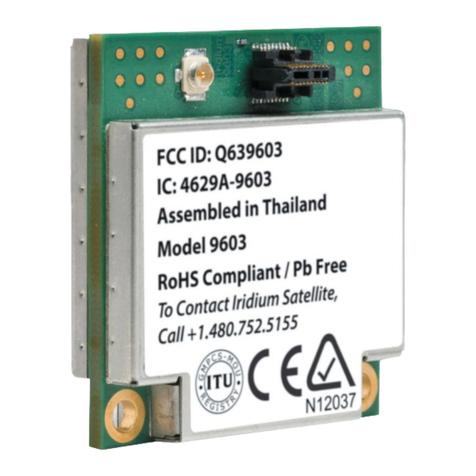
Iridium
Iridium 9603 Developer's guide
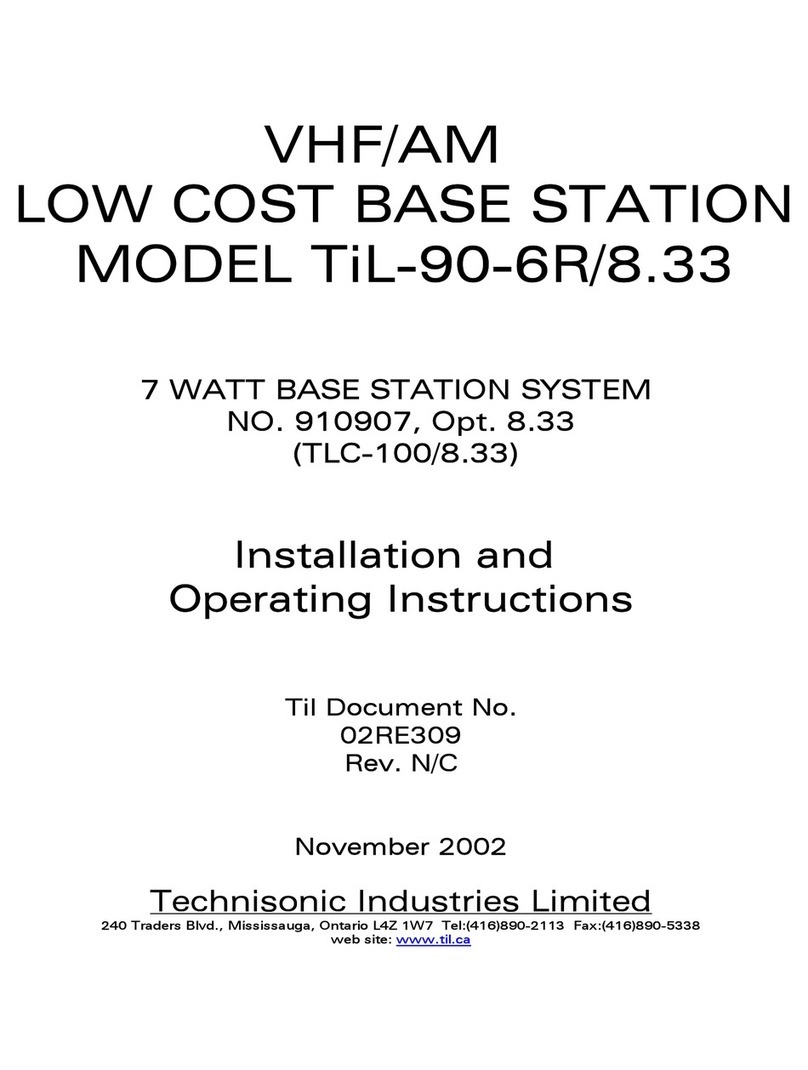
Technisonic Industries Limited
Technisonic Industries Limited TiL-90-6R/8.33 Installation and operating instructions
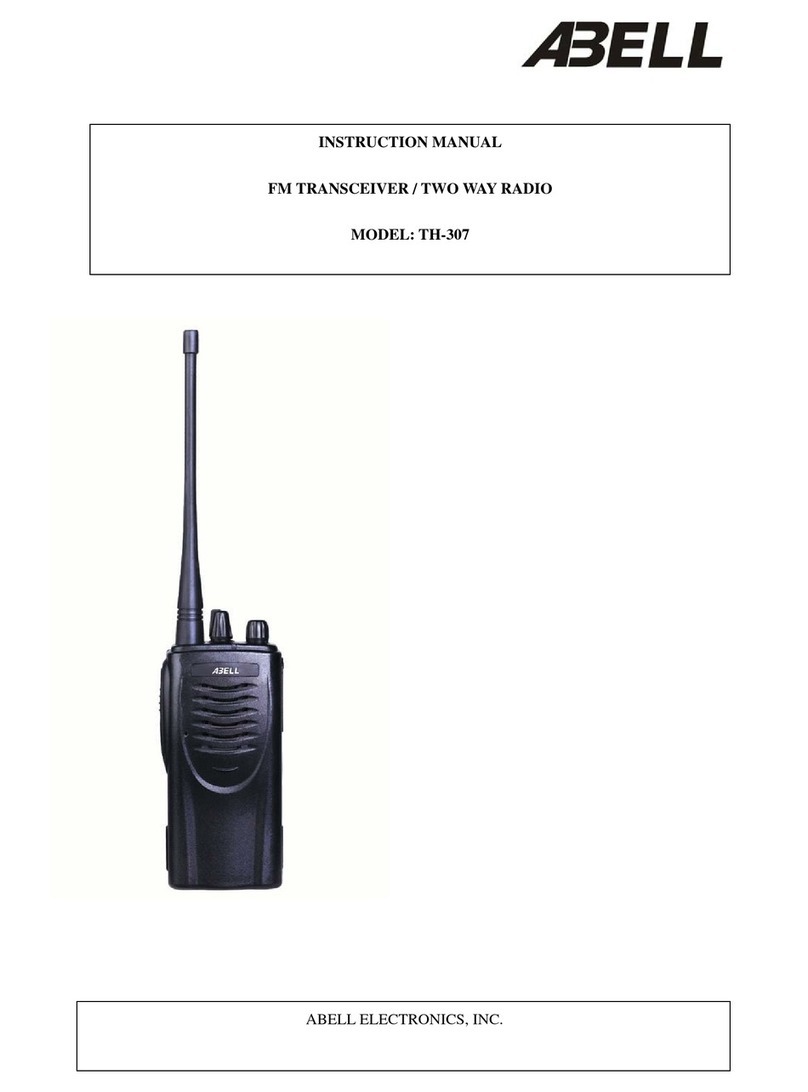
Abell
Abell TH-307 instruction manual
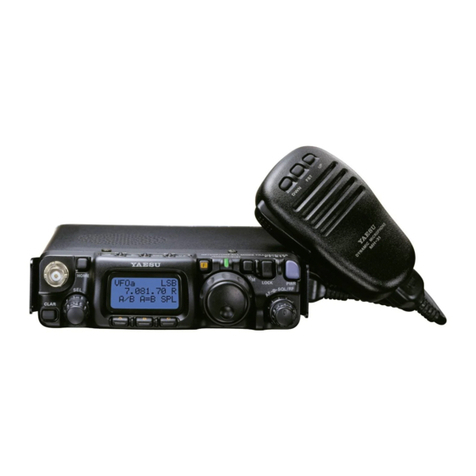
Yaesu
Yaesu FT-817ND Brochure & specs
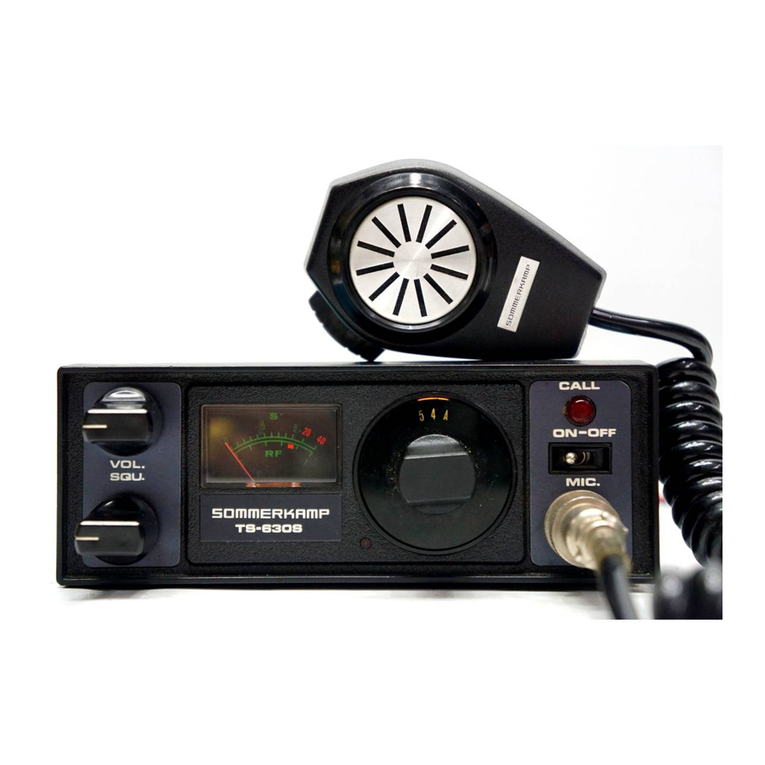
Sommerkamp
Sommerkamp TS-630S instruction manual
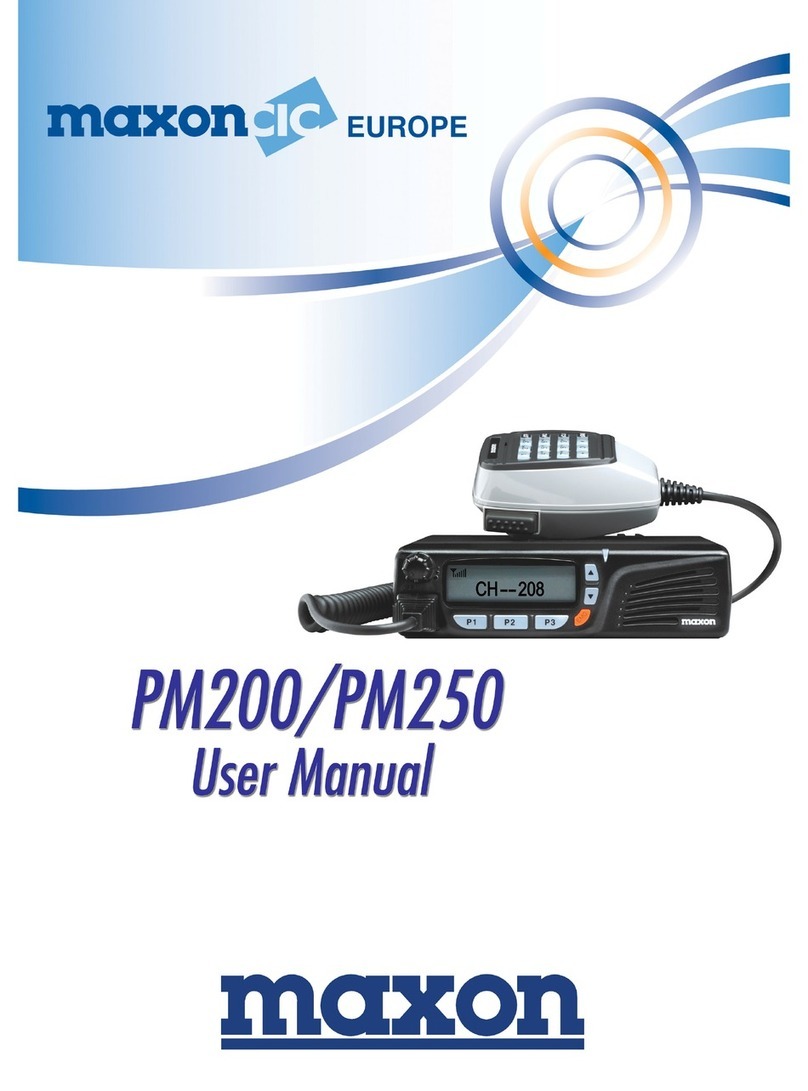
Maxon
Maxon PM200 user manual

AirTurn
AirTurn BT-105 user manual
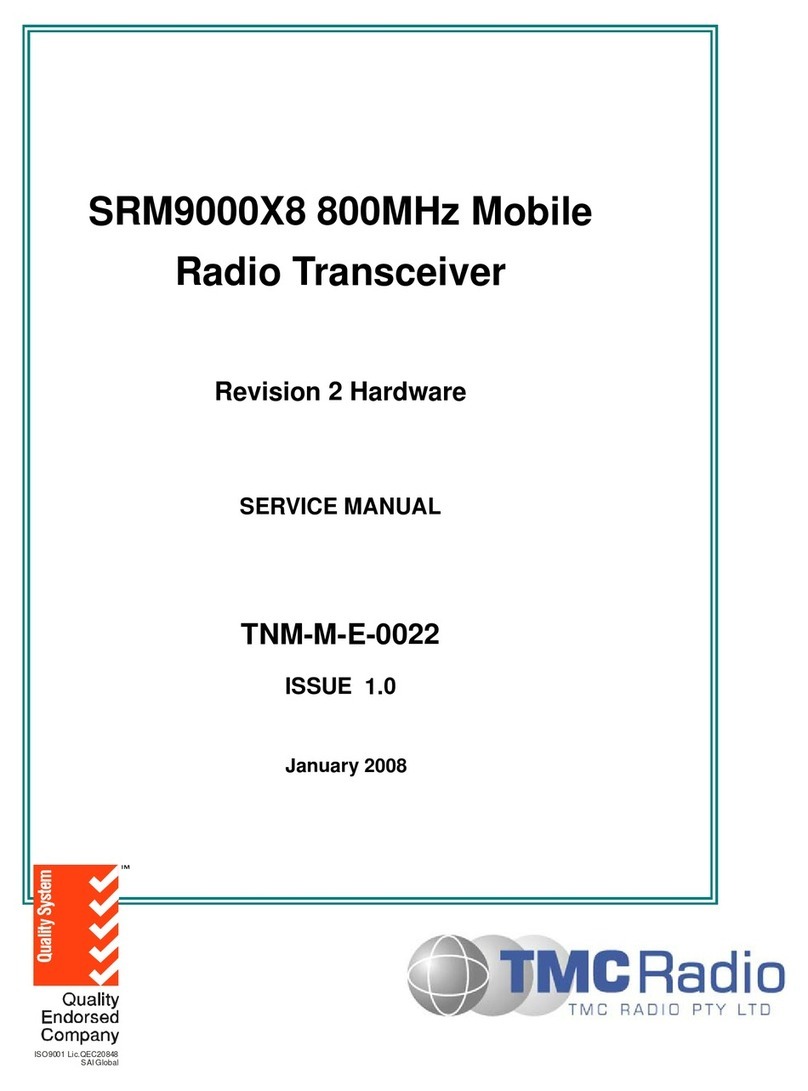
TMC Radio
TMC Radio SRM9000X8 Service manual

Expert Electronics
Expert Electronics SunSDR2 DX manual
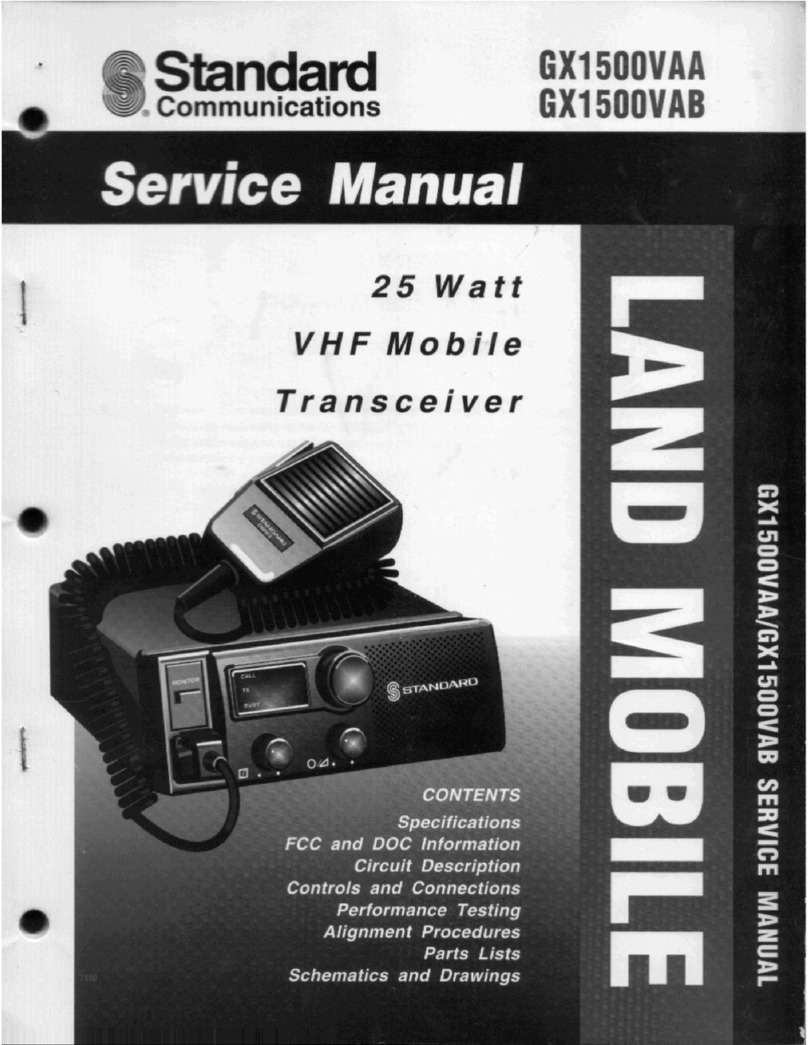
Standard Communications
Standard Communications GX1500VAA Service manual
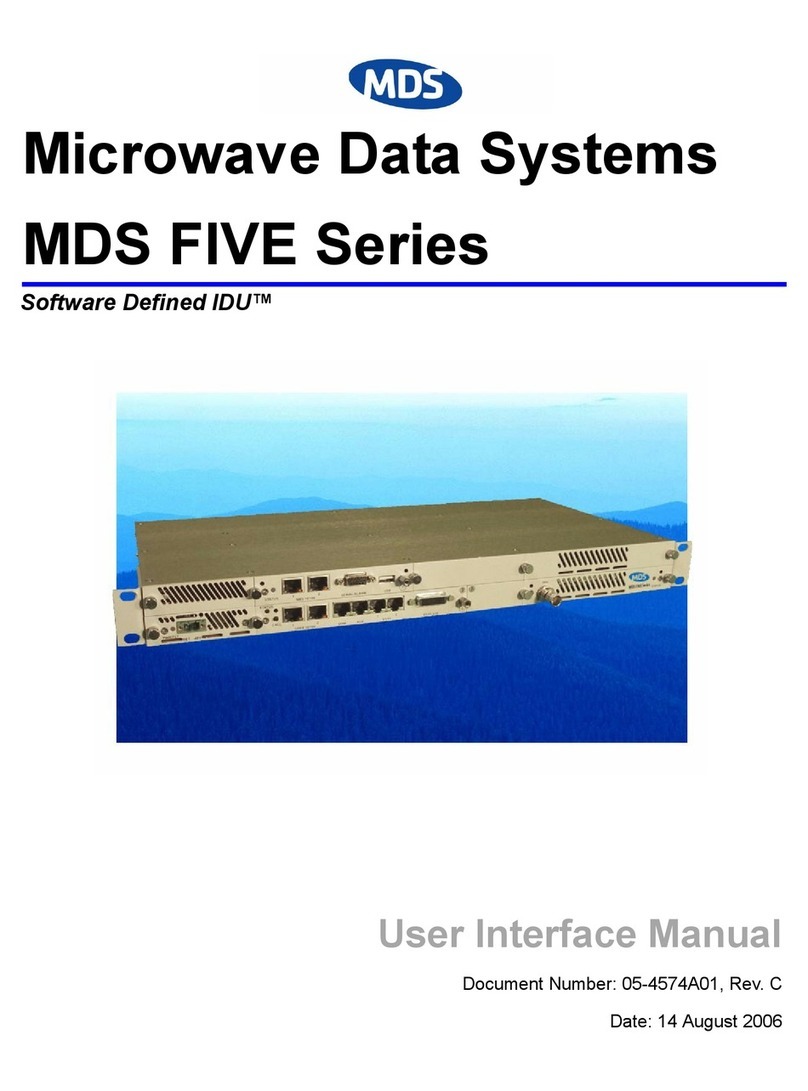
Microwave Data Systems
Microwave Data Systems MDS FIVE Series USER INTERFACE MANUAL
